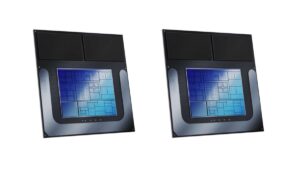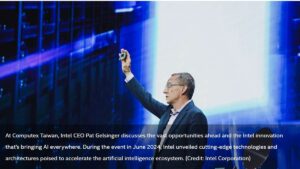3 Tech Giants in Shocking Showdown: 1 Is DONE? (You Won’t Believe Who!)
Qualcomm’s powerful Snapdragon X chips are poised to shake up the laptop market, traditionally dominated by Intel. Intel’s response seemed weak, focusing on future tech rather than concrete offerings. Nvidia’s CEO stole the show with a focus on broader AI applications, including a “digital twin of Earth” project.
CONTENTS: 3 Tech Giants in Shocking Showdown
- Qualcomm challenges Intel in laptops
- Intel vague on Lunar Lake details
- Intel defensive at Computex
- Intel lags, boasts future tech
- Qualcomm disrupts laptop market
- Nvidia CEO steals the show
- AI buzz overshadows hardware
- Focus on practical AI applications

Qualcomm challenges Intel in laptops
3 Tech Giants in Shocking Showdown
Computex Taipei marked a significant shift in the tech landscape, highlighting a potential end to an era dominated by Intel. Intel found itself on the defensive, with Nvidia challenging its crucial and profitable server market, and Qualcomm making strides in the laptop sector, traditionally Intel’s stronghold.
Qualcomm’s presence was particularly noteworthy. They introduced a range of devices powered by their Snapdragon X Series, including the Elite and Plus versions, with the Elite leading the pack. These weren’t mere concept announcements; the first devices are slated for release on June 18, 2024, indicating they have been in production for quite some time.
The industry support for Qualcomm was immense, with almost every major manufacturer participating in the launch. Qualcomm showcased various laptop designs on stage, joined by several manufacturers and Microsoft’s CEO, Satya Nadella, who spoke about the promising future with Qualcomm.

Intel vague on Lunar Lake details
As for Intel, their performance at Computex was somewhat underwhelming. Prior to their keynote, they introduced a dozen top executives from key laptop manufacturers such as Acer, Asus, Compal, and Wistron, who all sat in the front row the day after Qualcomm’s presentation.
During the keynote, Intel unveiled their Lunar Lake platform but left out many crucial details. Most notably, they couldn’t clearly explain how Lunar Lake would match up to the Snapdragon X Elite, which led to significant concerns and skepticism among the attendees.
Intel defensive at Computex
Intel CEO Pat Gelsinger leaned heavily on the company’s history and its relationship with Taiwan during his presentation. He highlighted the significance of Intel’s 40-year connection to Taiwan, especially noteworthy given the current tensions between China and Taiwan. This focus on Taiwan was echoed by other companies at Computex, emphasizing the island’s importance.
Gelsinger also made several references to the x86 architecture’s history, seemingly to convey a message of resilience and long-standing presence in the industry: “Hey, we’ve always been here and we’re not afraid.” However, the overall impression was quite the opposite. The keynote lacked the confidence expected and did not effectively counter the new competition, coming across as more defensive than assertive.
Intel lags, boasts future tech
3 Tech Giants in Shocking Showdown
Lunar Lake is not set to be a competitor until later. The display for Lunar Lake laptops—note that the chip isn’t launching until the third quarter—didn’t help Intel’s case. The setup appeared hastily assembled, reminiscent of a quickly ordered Ikea shelf. The message seemed to be, “Look at us, we have more laptops than Qualcomm!” but these laptops won’t be available on June 18, only months later. Consequently, there were few actual announcements of Lunar Lake laptops at Computex.
By the third quarter, Intel hopes to debunk the high performance requirements myth of its x86 processors. Gelsinger almost defiantly called Lunar Lake the “MythBuster” among x86 processors, claiming x86 technology is “at its finest.” One impressive stat was that Lunar Lake is supposed to consume 40 percent less power, though this was based on a YouTube benchmark, which left some skeptical. A simple reference to potential battery life might have been more convincing.
Lunar Lake also features an NPU with 48 TOPS, 3 TOPS faster than Qualcomm’s and 2 TOPS slower than AMD’s. Speaking of AMD, it introduced its Ryzen AI CPUs at the opening keynote, technically before Nvidia’s announcement. However, AMD had a minimal presence at Computex compared to Intel and Qualcomm, who were heavily advertised both in the exhibition halls and throughout the Taipei metro. This intense competition was not seen at last year’s Computex.

Qualcomm disrupts laptop market
This intense competition culminated in a real embarrassment during Intel’s keynote. At the end of the presentation, Intel showcased a video of various CEOs proclaiming “I’m with Intel.” However, many of these CEOs had been on stage with Qualcomm the previous day, proudly promoting their new ARM products. This highlighted the growing excitement and tension in the laptop sector.
Qualcomm’s recent moves indicate a shift in the market. Historically, there haven’t been many laptop designs featuring Qualcomm SoCs, and previous generations, like the 8cx Gen3, have largely faded into obscurity, with missing NPU displays in the Task Manager frustrating some users. The Snapdragon X Elite and X Plus are poised to change this perception, aiming to present a more future-ready platform.
Initial signs suggest Qualcomm’s strategy might succeed. In the laptop market, Qualcomm appears poised to capture some of Intel’s market share. Their foray into the desktop segment, likely focusing on the mini PC market, is still forthcoming. However, Qualcomm has yet to demonstrate that it can achieve high performance with strong heat management, an area where Intel and AMD traditionally excel.
Nvidia CEO steals the show
Qualcomm CEO Christiano Amon declared at his keynote that Qualcomm is “here to stay in the neighborhood.” This marks a significant shift in the laptop market, posing a substantial threat to Intel. To counter this, Intel seems to be gearing up with Panther Lake, while in the desktop segment, Arrow Lake—a potentially fast SoC slated for 2024—aims to introduce AI capabilities with a speedy NPU.
In the server market, Intel is expected to face intense competition from Nvidia. Nvidia’s CEO, Jensen Huang, a prominent figure in Taiwan, strategically hosted their keynote just before Computex, followed by their Nvidia AI Summit. This summit provided Taiwanese companies with insights into the future, with most presentations in Chinese. Nvidia went all out, renting an entire floor of the Grand Hilai and filling lecture halls with attendees. Huang’s presentation was comprehensive and impressive, managing to fill the NTU Sports Center with over 4,000 seats despite heavy rain.
Nvidia’s focus has shifted towards Huang as a key figure, while product details took a back seat temporarily. Unlike companies like Dell and HPE, which obscure hardware details, Nvidia and Huang continue to share technical data and future roadmaps at keynotes. However, some critics pointed out the lack of new announcements, finding the CEO-centric presentation style somewhat unusual for the typically tech-focused industry.
AI buzz overshadows hardware
3 Tech Giants in Shocking Showdown
Nvidia’s recent presentation may have left gamers disappointed, as the focus shifted away from traditional graphics cards towards broader applications for GPUs. During the keynote, Nvidia’s CEO humorously gestured towards a full 19-inch rack, emphasizing that GPUs are now much more than just gaming accelerators. While he briefly displayed a “real” graphics card on stage, no new gaming-related announcements were made.
This shift in focus towards broader applications highlights the different approaches taken by Nvidia and Intel. Nvidia is heavily invested in proprietary technologies, while Intel emphasizes open concepts, as seen with their presentations of Gaudi 2, Gaudi 3, and the Xeon 6. Intel’s commitment to standards, along with competitive pricing strategies, is reminiscent of AMD’s position in the desktop and laptop market, possibly indicating a shift in the competitive landscape.
The emphasis on artificial intelligence (AI) was a common theme among all participants at Computex. AI was seemingly portrayed as essential across various products, even cases and mice. However, discerning meaningful information from the buzzwords proved challenging. Qualcomm, for example, showcased an AI vision where users interact naturally with their Snapdragon PCs, even placing orders for appliances if repairs aren’t worthwhile. This ambitious vision recalls the grand promises of projects like Google Glass, which have since faded into obscurity.
Focus on practical AI applications
3 Tech Giants in Shocking Showdown
While ambitious visions like Qualcomm’s AI integration into everyday tasks are intriguing, progress on a smaller scale is more practical, especially considering the limitations AI faces in areas reliant on specific knowledge. For instance, experiments with food packaging and hotel histories revealed that the internet often lacks sufficient information, leading AI to generate inaccurate or repetitive responses.
However, certain applications like image generation already demonstrate promising results, depending on the AI’s intended task. NPUs in laptops are well-suited for such tasks, while professional AI accelerators primarily operate in cloud or large-scale solutions.
Nvidia’s vision of creating a digital twin of Earth, dubbed the “second Earth,” is particularly exciting. This project aims to construct a detailed replica of our planet, facilitating advancements in weather prediction among other applications. Taiwan, with its challenging weather conditions, serves as a prime example for this endeavor.
Additionally, Nvidia’s focus on “Physical AI,” where AI learns and adheres to physical laws, is noteworthy. This development is crucial for fields like robotics, especially in the advancement of humanoid robots.
While AI has become a pervasive buzzword, it’s essential to distinguish between marketing hype and tangible benefits. While many products tout AI capabilities, only a few are likely to deliver significant advantages in practical applications.
Check out TimesWordle.com for all the latest news
You must be logged in to post a comment.